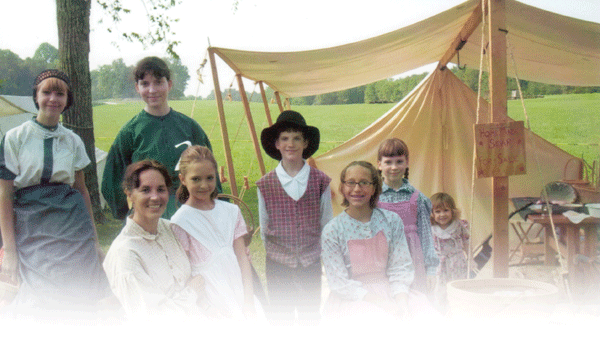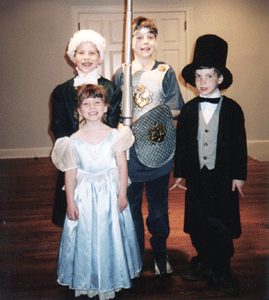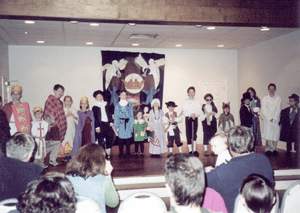
One of the beauties of homeschooling is that it crosses age lines. Not
only do classes often include children from elementary school through
high school, but also several generations often get involved in the
homeschool.
We saw this beautifully illustrated when we began a chapter of the
National History Club.
The National History Club (or NHC) was started in 2002 to encourage the
study of history by helping students and teachers to form local chapters
in middle schools and high schools. These chapters create their own
projects and activities and have access to resources of the NHC such as
the newsletter, student of the year awards, and submission of papers to
The Concord Review. More than 250 schools have local chapters in 42
states.
As one of the first homeschool chapters, here is our story.
The Goal

|
|
Historians at play for the Living Timeline
|
The goal of the National History Club is to inspire more students to
interact with the past. Among American school children, history has been
a failing subject. Every year another study reveals that a majority of
students can’t name the Bill of Rights or which country the United
States fought in the Revolutionary War. The NHC seeks to reverse this
trend by providing ways for students to experience history.
Our local history club chapter began when several homeschool students
attended the National History Day and learned about the NHC. We decided
to stir up interest by hosting a debate. We invited homeschoolers to
join us to deliberate “Who was greater: Alexander the Great or Augustus
Caesar?” We were surprised by the fervor of our students.
Once we had a core of students, we began planning what we would like to
do.
Activity-Based
Our group brainstormed about fun ways to get students involved. The
students themselves took leadership roles, such as president and
treasurer, and took responsibility for planning how often we would meet.
They decided to make our club “activity-based” rather than a monthly
meeting. They met about once every six weeks for a special event planned
by the group. As homeschoolers we naturally included younger brothers
and sisters, and later learned that this was endorsed by the NHC. Some
of our activities were focused on the group: for example, a college
professor led our group in a discussion of Judaism in the time of
Shakespeare.
Our group really gained momentum, however, when we started reaching out
beyond our club.
Beyond Our Club
Since we live near several Civil War battlegrounds, it was a natural
choice to volunteer for a reenactment that was held for elementary
school children. We dressed in period costume and hosted a sing-along of
Civil War era folk songs.
The club members began to see how they could help other students
participate in history.
To top off the experience, one of our homeschool mothers had a Civil War
tent, and she invited the students to camp with the reenactment troops.
They got to be part of the camp life: attending a ball, trying their
hands at blacksmithing, and watching the battle.
A Living Timeline

|
|
The students got to be part of a camp life: attending a ball, trying their hands at black-smithing, and watching the battle
|
Our next project was a Living Timeline for our local homeschool group.
Most of the students were too young to join our NHC chapter, but our
history club wanted to spark their interest in history. We asked the
students to dress as historical figures and to bring three facts about
their chosen person written on an index card (including the years of
their life.)
As the students arrived, the club members organized the children in
chronological order for the living timeline. It was interesting to see
Queen Isabella next to Galileo and William Taft next to Alexander
Fleming.
The living timeline spread across the stage and each child had a turn to
step forward and say one sentence about his historical figure (such as,
“In 1492 Columbus sailed to America”).
Next, we divided the students into two teams and used their index cards
to ask our quiz questions. The children would scan the teams for
inspiration on tricky questions such as “Who was the 27th president?”
Meanwhile, a team of club members identified winners of our numerous
awards, such as “most daring,” “most powerful,” and even “most
colonial!” (We created an award for each child.)
We wrapped up our Living Timeline with the award ceremony and time for
refreshments.
Older Generations
While the NHC reaches out to younger students, it also has the rare
ability to draw in the older generations. The potential to have parents,
grandparents, and family friends visit the club to share their
experiences makes the local chapter one of the most successful ventures
in integrating all ages into a homeschool. NHC chapters have invited
Holocaust survivors, elderly experts on local history, and decorated
veterans to speak for their groups. There is nothing like meeting real
people for bringing history alive.
The Newsletter
Local chapters receive the biannual newsletter for inspiration for club
activities. We have gleaned great ideas by reading about other clubs.
One idea that we used was a medieval feast for our families. Even the
parents dressed up!
Local chapters also have the opportunity to contribute to the
newsletter. Our club was thrilled to see their photo and the description
of their activities in the newsletter.
The Concord Review
The National History Club was founded by The Concord Review, the
prestigious quarterly journal that publishes research papers written by
high-school students. The NHC encourages students to submit papers to
the Review, where we are called “homescholars.” One of our members
accepted the challenge and was selected for publication, later winning
the Emerson Prize.

|
|
Our little Betsy Ross
|
Those who are published receive 12 reprints of their article, which can
be sent with college applications. Submission to
The Concord Review
costs $40. In addition to receiving the writing assessment, which is
comparable to national standards used by schools such as Harvard and
Yale, the submission fee comes with four issues of
The Concord Review.
Visit www.tcr.org to learn more.
History Student of the Year Award
Each year the NHC, along with George Washington’s Mount Vernon Estate,
hosts the History Student of the Year Award. Each chapter chooses a
recipient for the prize, which is supplied by the NHC. The prize is a
signed copy of a history book with a special bookplate. The award
winners are posted on the NHC website.
“Home Scholars”
The National History Club has been a fun way for our students to learn
history and encourage others in the same pursuit. Our students have
taken leadership roles, won awards, and learned how to use history as a
bridge to older generations. To learn how to start your own chapter,
visit nationalhistoryclub.org and download their useful guide.
The National History Club is a rich resource for “home scholars” who
want to stimulate the study of history in their own communities.
Joyce McPherson is the creator of the online programs “Homeschool Tools”
and “Shakespeare Tools,” as well as the author of a series of
biographies for Greenleaf Press. With her husband, Garth, she
homeschools their nine children. She can be reached through
teachingtools.org or at mcpclan@comcast.net.